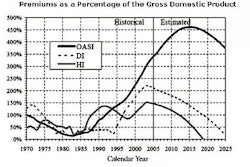When describing the Deficit Reduction Act (DRA) of 2005 and its effects, healthcare regulators aren't afraid to use the clearest and most direct language: "With these changes, you're either on the wave of change or under it," said Brian Flood, inspector general for the Texas Health and Human Services Commission, to an audience of compliance officers and auditors during the Health Care Compliance Association (HCCA) Compliance Institute in Las Vegas earlier this year.
"There's going to be this complete change -- a revolution in the industry -- for Medicaid enforcement, and I don't think that point has been driven home," he said.
"This is a slam dunk for enforcers," said Frank Sheeder, a partner in the Dallas office of the law firm Brown McCarroll, regarding the DRA's requirement that providers educate employees and contractors on the False Claims Act.
"If (enforcers) come in and you don't have the required elements in place, your entire Medicaid reimbursement will be at risk," he said at the HCCA conference.
If you think these warnings sound excessive, think again. The DRA will truly change the way that the U.S. enforces Medicaid fraud rules -- and it all starts on January 1 next year when the rules go into effect. This leaves providers with only three months to prepare.
An overview of the DRA
If you've been ignoring news about the DRA, the following is a basic outline that describes much of what auditors and compliance officers need to know:
The DRA dramatically shifts the federal enforcement focus to Medicaid. The federal government is under heavy pressure from Congress to strengthen federal enforcement of Medicaid fraud laws. The shift is understandable -- the U.S. will spend $192 billion on Medicaid this year with little federal oversight. The DRA increases federal supervision.
"Historically, Medicaid has been regulated by the states," Flood said. "That's been the federal position forever and ever, amen. That is not the federal position anymore."
The DRA provides funding for the federal Medicaid fraud enforcement shift. The DRA backs up the focus on federal Medicaid enforcement with added resources. Specifically, the DRA:
Increases the number of federal Medicaid enforcement employees from eight to 100.
Creates a new Medicaid Integrity Program (MIP) staffed with federal agents to lead national Medicaid fraud enforcement. The MIP will receive $5 million in seed money next year, and will become a $75-million-per-year operation by fiscal year 2009. The Centers for Medicare and Medicaid Services (CMS) has not decided where the MIP Division of Field Operations headquarters will be based, but has said it will likely be in five of these so-called "fraud hot spots":
- Southern California
- South Florida
- Gulf Coast
- New England/New York/New Jersey
- Chicago-Detroit area
Provides the federal Office of Inspector General (OIG) an additional $25 million per year with which to conduct Medicaid fraud investigations.
Allows CMS to hire contractors to review the actions of those seeking payment from Medicaid, conduct audits, identify overpayments, and educate providers and others on program integrity and quality of care.
The DRA provides new data related to Medicaid enforcement. The DRA creates several federal programs to track the best practices and benchmark data.
They include the following:
Medicaid transformation grants: This program encourages states to develop and share successful enforcement methods. CMS will give states $150 million in 2007 and 2008 to fund research into adopting innovative systems to get more value out of Medicaid spending.
Medi-Medi: This program matches Medicare and Medicaid claims data to find patterns of fraud that were previously undetectable without the comparison data.
Payment Error Rate Measurement (PERM): This program will track Medicaid claims error rates. State and federal enforcement agents will use PERM rates to provide a snapshot of overall compliance, and locate suspicious patterns and outliers that may require review, correction, or recoupment.
Your facility will need to begin education on the federal and state false claims acts. To comply with the DRA, healthcare entities that receive $5 million or more in Medicaid payments per year must take the following steps:
Establish written policies for all employees, including management and any contractor or agent. The policies must give detailed information about the False Claims Act (and any state counterpart), whistleblower protections, and provisions about the facility's policies and procedures for detecting and preventing fraud, waste, and abuse.
Include in any employee handbook a specific discussion of employees' rights to be protected as whistleblowers, and the facility's policies and procedures for detecting and preventing fraud, waste, and abuse.
Even if your facility does not receive $5 million in Medicaid payments, experts still advise that you provide training on the False Claims Act (and any state counterpart) because the requirement will set a standard for all providers.
Many industry analysts find this aspect of the act interesting because it marks the government's first departure from its stance that hospital compliance programs are voluntary.
By requiring written policies for detecting and preventing fraud, waste, and abuse, the DRA has made mandatory what was previously voluntary.
More states will create their own false claims acts. The DRA encourages states to pass their own false claims acts. States that create, or have in place, a false claims act that is at least as strong as the federal False Claims Act will receive 10% of any whistleblower recoveries.
"Ten percent of the take can be a considerable chunk of change, especially to a state that needs that funding source to set up their programs or comply with the DRA," Flood said.
By September 1, 16 states had passed false claims acts according to the Taxpayers Against Fraud Education Fund. Many other states are writing false claims acts, as well. For a breakdown of state false claims acts, visit www.taf.org/statefca.htm.
Chain reactions
Industry experts say the long-term influences of the DRA will be far-reaching and dramatic, causing a chain reaction of enforcement.
For example, the federal pressure will lead more states to audit their Medicaid programs. The PERM program, in particular, will hold state regulators accountable to federal officials. In turn, the state regulators will crack down on individual providers, according to Flood.
"If you think about it conceptually, every state will be held to a particular error rate," he said. "As the regulator, I am also held to that error rate. If those error rates are naturally or unnaturally high, who is going to get in trouble? First, I will. The second person is you, as a provider."
Additionally, Flood expects that more individuals will become whistleblowers as they learn more about the False Claims Act.
"As you educate individuals on the ability to complain, they do," he said. "In the beginning, I think you're going to see a surge of litigation."
Flood predicts that federal enforcers will come down especially hard on one provider at some point during the first several months of the program.
"They'll find the bad guy, stand him up in the public realm, and make an example of him," he said. "In every industry -- I don't care which one it is -- there's generally that one bad guy that everybody knows. When law enforcement gets the resources that it needs, (it) will hunt that entity down, show it to the others, and say, 'Don't do this.'"
Ensure that your compliance program is ready, so that you don't become the example, Flood said.
An act by any other name . . .
Sheeder offered a few names for the DRA other than the Deficit Reduction Act.
"Interestingly, it's not called the Medicaid Fraud Prevention Act of 2005," he said. "It could be called the Daunting Regulatory Announcement. For compliance officials, it's the Definitely Relevant Act."
"If you can't get buy-in at the top, or the resources to deal with it, you'll experience the Diminished Revenue Age," Sheeder said.
Now's the time to prepare
The DRA takes effect on January 1 next year. Use the following suggestions to prepare:
Initiate False Claims Act training
First, the DRA requires entities that receive $5 million or more in Medicaid payments to establish written policies on the False Claims Act for all employee, including managers, contractors, and agents.
"If you are a multihospital system, don't forget to determine whether there are false claims acts in the states where you operate," Sheeder said. "You also need to provide reporting hotline numbers for those states."
Although the DRA doesn't specifically require training per se, most experts agree that -- in addition to updating employee handbooks -- the providers should train their employees on the False Claims Act.
CMS' Comprehensive Medicaid Integrity Plan for the Medicaid Integrity Program released in July this year also specifically calls for training.
It states that the act requires any provider receiving $5 million or more in Medicaid payments to "provide education to its employees and contractors on both the federal and state False Claims Acts." The report also says CMS plans to issue guidance on this issue, but does not specify when.
Note that the document states that your facility should train contractors and agents in addition to employees. Sheeder recommends that facilities develop a process for communicating effectively with contractors about the matters listed in the DRA.
Ensure effectiveness program
It may seem obvious, but one way to protect your facility in the wake of the DRA is to do what you've always tried to do -- demonstrate that you have a strong compliance program.
Flood says if a provider has made an honest mistake, his office is less likely to pursue punitive action against an entity with an active compliance program.
He says investigators will likely ask the following questions when scrutinizing providers:
- Do they have a compliance plan?
- Do they have a risk analysis?
- Do they understand where their risk is?
- Are they trying to address those risks?
- Are they attempting to produce clean claims?
- Are they trying to make adjustments to the program?
- Are they generally compliant with generally accepted business practices?
Educate your colleagues
To prepare your facility for the DRA, you'll need to inform board members and managers about the act, and ensure that you achieve buy-in.
Show that the federal government will spend $100 million per year on Medicaid enforcement, and that the DRA makes compliance programs mandatory.
Gather necessary materials
Gather copies of Medicaid regulations, coverage manuals, guidance, and updates for every state in which your facility or system operates.
"Don't forget that your hospital may be billing Medicaid programs in states other than the one in which you're located," Sheeder said.
Update your work plan
Make sure that your audits examine both Medicare and Medicaid cases. Use dual-purpose testing where possible.
"As part of this step, identify those issues that are unique to Medicaid programs," Sheeder said. "Analyze them for significance and likelihood of error, and add them to your audit work plan."
Also review each Medicare audit target and see if there is a similar corresponding Medicaid rule.
"A good look through your state's Medicaid regulations and coverage manuals may reveal issues that you never considered before," Sheeder noted.
By Rebecca Griffin
AuntMinnie.com contributing writer
October 6, 2006
This article originally appeared in the "Strategies for Health Care Compliance," a monthly newsletter published by HC Pro that is designed specifically for healthcare professionals tasked with compliance issues.
Related Reading
Study finds 87% of DRA reimbursement below procedure cost, September 19, 2006
Reassignment rule proposal offers mixed bag for imaging, August 18, 2006
DRA cuts affect more than imaging providers, August 2, 2006
House bill seeks to delay DRA imaging cuts, June 29, 2006
DRA 2005 in practice: Where the rubber meets the road, April 27, 2006
Copyright © 2006 HC Pro



















